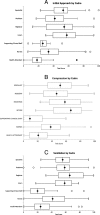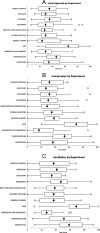Assessment of cardiopulmonary resuscitation knowledge and skills among healthcare providers at an urban tertiary referral hospital in Tanzania
- PMID: 30514275
- PMCID: PMC6278030
- DOI: 10.1186/s12913-018-3725-2
Assessment of cardiopulmonary resuscitation knowledge and skills among healthcare providers at an urban tertiary referral hospital in Tanzania
Abstract
Background: Early and effective CPR increases both survival rate and post-arrest quality of life. In limited resource countries like Tanzania, there is scarce data describing the basic knowledge of CPR among Healthcare providers (HCP). This study aimed to determine the current level of knowledge on, and ability to perform, CPR among HCP at Muhimbili National Hospital (MNH).
Methods: This was a descriptive cross sectional study of a random sample of 350 HCP from all cadres and departments at MNH from October 2015 to March 2016. Each participant completed a with 25 question multiple choice and fill-in-the-blank CPR test and a practical test using a CPR manikin where the participant was videotaped for 1-2 min. Two expert observers independently viewed the videos and rated participant performance on a structured data form. The primary outcome of interest was staff member overall performance on the written and practical CPR testing.
Results: We enrolled 350 HCPs from all 12 MNH clinical departments. The median participant age was 35 (IQR 29-43) years, 225 (64%) were female and 138 (39%) had clinical experience of less than 5 years. Only 57 (16%) and 88 (25%) scored above 50% in written and practical tests, respectively according to local minimum passing test score and 13(4%) and 30 (9%) scored above 75% in written and practical tests, respectively according to international minimum passing test score on CPR. The 233(67%) HCP who reported prior experience performing CPR on an adult patient scored higher on testing than those without; 40% (IQR 28-54) versus 26% (IQR 16-42) respectively, but both groups had median scores <50%.
Conclusion: The level of CPR knowledge and skills displayed by all cadres and in all departments was poor despite the fact that most providers reported having performed CPR in the past. Since MNH is a tertiary referral hospital, it may reflect the performance of resuscitation status of other local health centers in Tanzania and other low-income countries to employ a formal system of training every HCP in CPR. Staff should be certified and assessed regularly to ensure retention of resuscitation knowledge and skills.
Keywords: Cardiopulmonary arrest; Cardiopulmonary resuscitation; Emergency department; Knowledge; Provider.
Conflict of interest statement
Ethics approval and consent to participate
The study protocol was reviewed and approved by the Institutional Review Board of the Muhimbili University of Health and Allied Sciences’ Institutional Review Board (MUHAS-IRB) and permission to collect data was obtained from relevant authorities at MNH. All participants provided a written informed consent prior to participation into the study.
Consent for publication
Not applicable.
Competing interests
The authors declare that they have no competing interests.
Publisher’s Note
Springer Nature remains neutral with regard to jurisdictional claims in published maps and institutional affiliations.
Figures


Similar articles
-
Outcomes of pediatric in-hospital cardiac arrest in the emergency department of a tertiary referral hospital in Tanzania: a retrospective cohort study.BMC Emerg Med. 2024 Oct 3;24(1):178. doi: 10.1186/s12873-024-01086-8. BMC Emerg Med. 2024. PMID: 39363293 Free PMC article.
-
Assessment of nurses' cardiopulmonary resuscitation knowledge and skills within three district hospitals in Botswana.Afr J Prim Health Care Fam Med. 2018 Apr 12;10(1):e1-e6. doi: 10.4102/phcfm.v10i1.1633. Afr J Prim Health Care Fam Med. 2018. PMID: 29781687 Free PMC article.
-
Assessment of nurses knowledge and skills following cardiopulmonary resuscitation training at Mbarara Regional Referral Hospital, Uganda.Pan Afr Med J. 2018 Jun 11;30:108. doi: 10.11604/pamj.2018.30.108.15398. eCollection 2018. Pan Afr Med J. 2018. PMID: 30364487 Free PMC article.
-
Associations between cardiopulmonary resuscitation (CPR) knowledge, self-efficacy, training history and willingness to perform CPR and CPR psychomotor skills: A systematic review.Resuscitation. 2019 May;138:259-272. doi: 10.1016/j.resuscitation.2019.03.019. Epub 2019 Mar 27. Resuscitation. 2019. PMID: 30928504
-
Knowledge and skill level among non-healthcare providers regarding cardiopulmonary resuscitation (CPR) training in the Middle East (Arab countries): a systematic review and meta-analysis.BMC Public Health. 2024 Aug 1;24(1):2081. doi: 10.1186/s12889-024-19575-7. BMC Public Health. 2024. PMID: 39090594 Free PMC article.
Cited by
-
Self-Assessed Capabilities, Attitudes, and Stress among Pediatric Nurses in Relation to Cardiopulmonary Resuscitation.J Multidiscip Healthc. 2023 Mar 3;16:603-611. doi: 10.2147/JMDH.S401939. eCollection 2023. J Multidiscip Healthc. 2023. PMID: 36896454 Free PMC article.
-
Evaluation of junior doctors' retention of knowledge and skills after simulation training in shockable rhythm cardiac arrest in a low-resource setting in Nepal.Resusc Plus. 2023 Aug 24;15:100448. doi: 10.1016/j.resplu.2023.100448. eCollection 2023 Sep. Resusc Plus. 2023. PMID: 37649875 Free PMC article.
-
Accuracy of two-rescuer adult CPR performed by medical registrars at a South African university.Afr J Emerg Med. 2023 Sep;13(3):199-203. doi: 10.1016/j.afjem.2023.06.006. Epub 2023 Jul 6. Afr J Emerg Med. 2023. PMID: 37456585 Free PMC article.
-
Knowledge of Basic Life Support among Doctors and Nurses Attending a Refresher Course in a Teaching Hospital in Southwest Nigeria.Niger Med J. 2022 Sep 12;63(4):304-311. doi: 10.60787/NMJ-63-4-77. eCollection 2022 Jul-Aug. Niger Med J. 2022. PMID: 38863472 Free PMC article.
-
Assessment of Cardiopulmonary Resuscitation Knowledge Among Physicians in the Pediatrics Department of an Urban Tertiary Referral Hospital in Ethiopia: A Cross-Sectional Study.Emerg Med Int. 2024 Oct 28;2024:8815197. doi: 10.1155/2024/8815197. eCollection 2024. Emerg Med Int. 2024. PMID: 39502495 Free PMC article.
References
-
- Field JM, Hazinski MF, Sayre MR, Chameides L, Schexnayder SM, Hemphill R, et al. Part 1: executive summary: 2010 American Heart Association guidelines for cardiopulmonary resuscitation and emergency cardiovascular care. Circulation. 2010;122(18_suppl_3):S640–S656. doi: 10.1161/CIRCULATIONAHA.110.970889. - DOI - PubMed
MeSH terms
LinkOut - more resources
Full Text Sources
Medical
Miscellaneous

